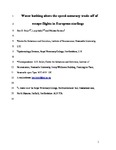Water bathing alters the speed-accuracy trade-off of escape flights in European starlings
| dc.contributor.author | Brilot, BO | en |
| dc.contributor.author | Asher, L | en |
| dc.contributor.author | Bateson, M | en |
| dc.date.accessioned | 2014-05-13T10:40:05Z | |
| dc.date.available | 2014-05-13T10:40:05Z | |
| dc.date.issued | 2009-10-01 | en |
| dc.identifier.issn | 0003-3472 | en |
| dc.identifier.uri | http://hdl.handle.net/10026.1/3004 | |
| dc.description.abstract |
Birds of most species regularly bathe in water, but the function of this behaviour is unknown. We tested the hypothesis that water bathing is important in feather maintenance, and hence should enhance flight performance. We manipulated European starlings', Sturnus vulgaris, access to bathing water in a 2 × 2 design: birds were housed in aviaries either with or without water baths for a minimum of 3 days (long-term access) before being caught and placed in individual cages either with or without water baths for a further 24 h (short-term access). We subsequently assessed the speed and accuracy of escape flights through an obstacle course of vertical strings. Birds that had bathed in the short-term flew more slowly and hit fewer strings than birds that were deprived of bathing water in the short term, whereas long-term access to bathing water had no significant effect on flight performance. Thus recent access to bathing water alters flight performance by altering the trade-off between escape flight speed and accuracy. We hypothesize that lack of bathing water provision could increase anxiety in captive starlings because of an increase in their perceived vulnerability to predation. This study therefore potentially provides an important functional link between the expression of natural behaviours in captivity and welfare considerations. © 2009 The Association for the Study of Animal Behaviour. | en |
| dc.format.extent | 801 - 807 | en |
| dc.language.iso | en | en |
| dc.title | Water bathing alters the speed-accuracy trade-off of escape flights in European starlings | en |
| dc.type | Journal Article | |
| plymouth.issue | 4 | en |
| plymouth.volume | 78 | en |
| plymouth.publication-status | Published | en |
| plymouth.journal | Animal Behaviour | en |
| dc.identifier.doi | 10.1016/j.anbehav.2009.07.022 | en |
| plymouth.organisational-group | /Plymouth | |
| plymouth.organisational-group | /Plymouth/Faculty of Health | |
| plymouth.organisational-group | /Plymouth/Faculty of Health/School of Psychology | |
| plymouth.organisational-group | /Plymouth/Faculty of Science and Engineering | |
| plymouth.organisational-group | /Plymouth/Faculty of Science and Engineering/School of Biological and Marine Sciences | |
| plymouth.organisational-group | /Plymouth/REF 2021 Researchers by UoA | |
| plymouth.organisational-group | /Plymouth/REF 2021 Researchers by UoA/UoA04 Psychology, Psychiatry and Neuroscience | |
| dc.rights.embargoperiod | Not known | en |
| rioxxterms.versionofrecord | 10.1016/j.anbehav.2009.07.022 | en |
| rioxxterms.licenseref.uri | http://www.rioxx.net/licenses/all-rights-reserved | en |
| rioxxterms.type | Journal Article/Review | en |


